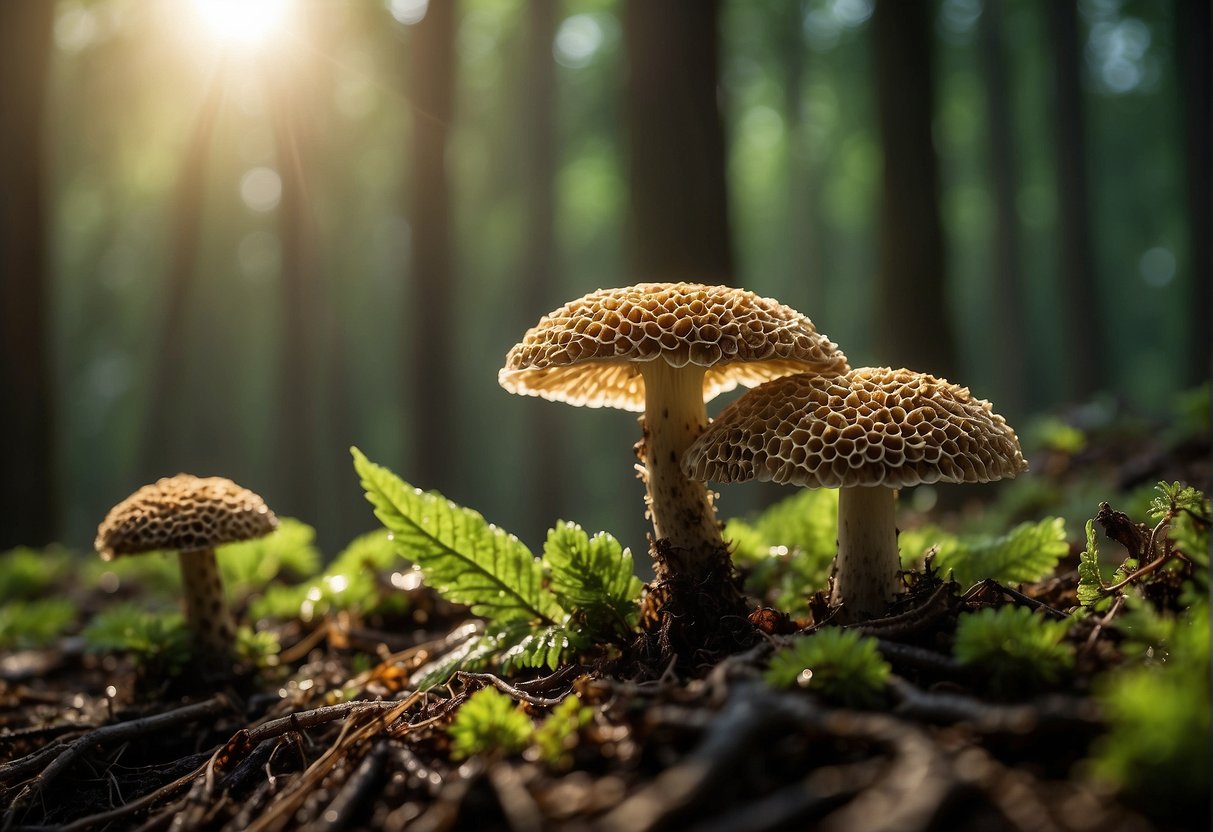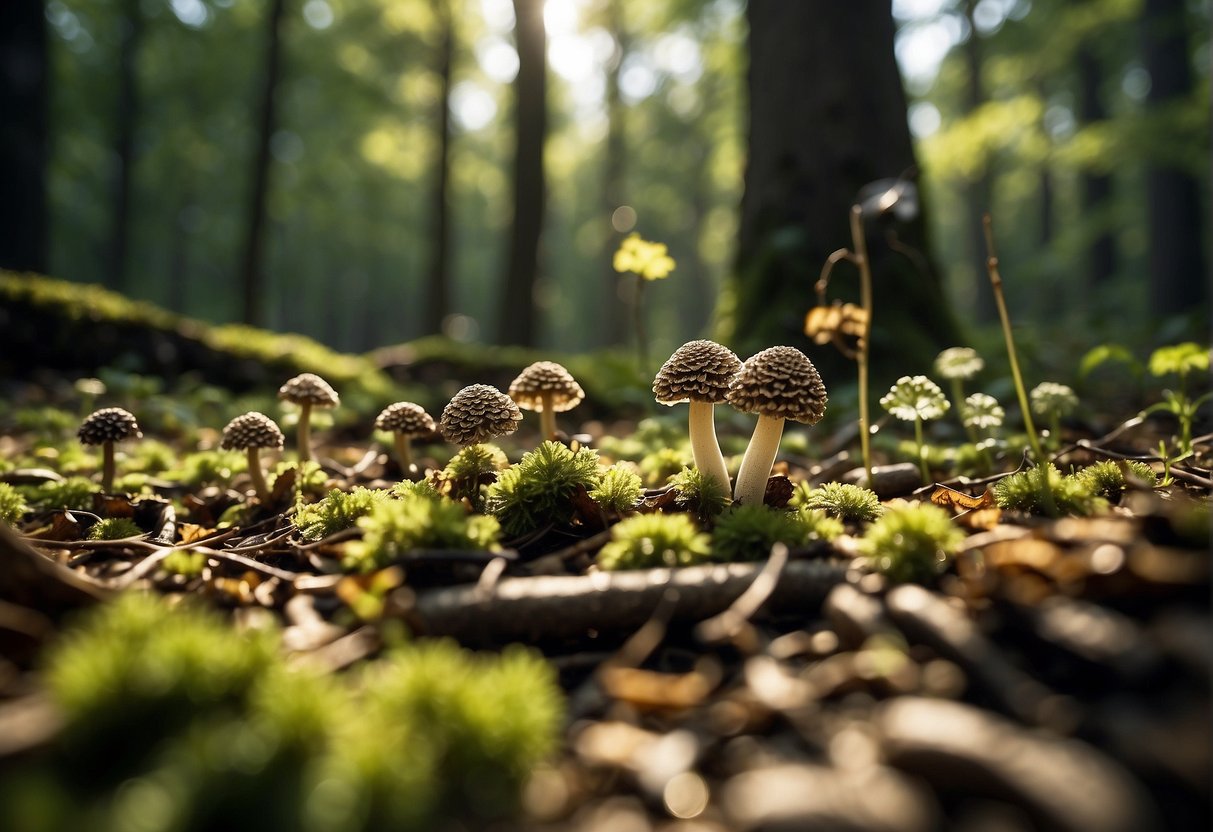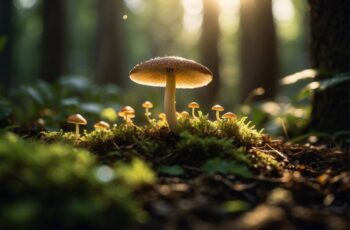Venturing into the realm of growing morel mushrooms brings you closer to nature’s most intriguing and rewarding foraging experiences. Morels are highly prized by gourmet chefs and outdoor enthusiasts alike for their distinctive taste and unique, honeycombed appearance. Unlike common mushrooms, morels require specific conditions to thrive, making them a fascinating challenge for those who prefer the soil under their feet and the satisfaction of a well-earned harvest.

You’ll find that these fungi are not your average garden crop. Morel mushrooms lack the green chlorophyll found in plants and therefore depend on a symbiotic relationship with trees to obtain nutrients. This partnership, coupled with their preference for certain soil types and weather conditions, means successfully cultivating morels often involves a blend of patience, skill, and a bit of foraging wisdom. Understanding the ideal conditions for morel growth is crucial—cool and moist weather patterns are particularly beneficial, giving rise to these elusive treasures of the forest floor.
As you embark on this natural culinary quest, remember that morel mushrooms symbolize the beauty of seasonal foraging. They emerge in the spring, signaling a change in the environment and the awakening of the woodland. By aligning your growing endeavors with the rhythms of the ecosystem, you give yourself the best chance of nurturing these sought-after fungi in your own backyard. With diligence and respect for their natural habitat, you can turn your outdoor space into a morel haven, fully embracing the role of not just a grower but also a steward of the land.
Morel Habitat and Lifecycle
Discovering the secrets of morel mushroom growth is essential for any outdoors enthusiast. Knowing the conditions under which morels thrive and their life cycle stages can greatly enhance your foraging or cultivation efforts.
Natural Habitats and Conditions
Morel mushrooms favor forests that offer dappled light, often after a forest fire, in spring or fall when the forest floor is still retaining moisture. Your best chance to find them is in wooded areas with loamy soil—a mix of sand, silt, clay, and decaying matter like leaves. This type of soil, possibly enhanced with peat moss or gypsum, provides the necessary nutrients and a proper balance of moisture and drainage for the mycelium—morel’s underground structure—to thrive. The ideal soil temperature is generally between 45°F (7°C) and 60°F (15°C), and the ambient air temperature should be from 50°F (10°C) to 70°F (21°C). High humidity, around 80% to 90%, is also a significant factor in the successful growth of morels in their natural habitat.
Understanding the Morel Lifecycle
Morels undergo a fascinating lifecycle that is inherently tied to their natural habitat. Normally in spring, morel fungi start their cycle as spores which land on suitable substrates and germinate to form a network of cells called mycelium. This mycelium remains hidden within the forest floor, extracting nutrients and waiting for the proper environmental cues to fruit. When conditions are right—considering factors like soil temperature, light, and moisture—the mycelium produces the fruiting bodies we recognize as morel mushrooms. These conditions typically align with spring temperatures and moisture patterns but can also occur in fall if the conditions are particularly conducive.
Cultivating Morels
To successfully cultivate morels, your attention to soil composition and environmental conditions is crucial. Understanding the specific needs of morel spores will help you create the right conditions for growth.
Soil Preparation and Requirements
Ideal soil for growing morels is rich in organic material, with a slightly alkaline pH of 7.0 to 8.0. You can use a mix of compost, hardwood chips, and a sprinkle of lime to adjust pH levels. The substrate should be loamy and well-draining but capable of retaining enough moisture. Prior to planting, incorporating wood ash can increase chances of growth, as morels have an affinity for such environments.
- Organic Matter: Crucial for nutrient supply
- Wood Ash: Enhances soil for morel affinity
- Lime: Modifies pH to the desired alkalinity
- Compost: Adds beneficial bacteria and nutrients
Planting and Watering Techniques
When planting morel spores, mix your spore slurry – a concoction of morel spores, molasses, and water – into the prepared soil. Molasses acts as a binding agent for the spores and also provides sugars that can benefit the growing fungi. Watering is essential but should mimic natural moisture levels. Avoid excessive watering which can lead to bacteria proliferation and disrupt morel growth.
- Spore Slurry Mix: 1 tablespoon molasses per gallon of water
- Watering: Keep soil moist but not saturated
Environmental Control for Growth
The microclimate for morel cultivation must be carefully managed. Ideal temperature ranges from 45°F to 70°F, with the soil around 45°F to 50°F for initial growth. Morels thrive in shaded areas, requiring indirect light and high humidity between 80% to 90%. Protect your cultivation area from extreme weather conditions and maintain consistent soil moisture without waterlogging.
- Temperature: Forest floor range of 45°F to 70°F
- Moisture: Consistent but not overbearing
- Shade and Humidity: Simulate a forest-like environment
By diligently managing these conditions and meticulously preparing your grow site, you can greatly increase your chances of successfully cultivating morels. Remember, patience is key, as morels can take time to establish themselves in their new environment.
Harvesting and Utilization of Morels
The journey from the forest floor to the dinner table is a rewarding experience for morel enthusiasts. Arm yourself with the knowledge to properly harvest, prepare, and preserve these highly sought-after mushrooms. Let’s ensure you get the most flavor and enjoyment from your foraged bounty.
Harvesting Morels
When you’re ready to harvest morels, timing and technique are crucial. Search in spring, ideally after rain when the soil is moist. Morels thrive on decaying wood and consistent moisture. To harvest:
- Pinch or cut: Use a knife or your fingers to sever the stem above the soil, preserving the mycelium for future growth.
- Forage responsibly: Only take what you need and can use, leaving some morels to spore and grow.
Harvesting Morels Properly – The Great Morel offers guidance on the life cycle and picking methods for longevity. Remember, correctly identify your morels; many edible mushrooms have toxic look-alikes.
Preparing and Cooking Morels
Fresh morels are a culinary delight, known for their complex flavor.
- Cleaning: Gently rinse with water, removing any forest debris.
- Slice: Cut longitudinally to ensure thorough cooking.
Explore various recipes to showcase their flavor:
- Sauté: Cook morels with butter and garlic for a simple yet sumptuous dish.
- Stuffing: Fill them with a savory mix, elevating their woodsy taste.
For more forms of preparation, check out Growing Morel Mushrooms: Expert Tips for a Bountiful Harvest, it provides gourmet ideas suitable for fresh morels.
Preservation Tips
Preserving morels allows you to enjoy them year-round. Key methods include:
- Drying: Lay them out on a screen or hang in a dry, airy space.
- Freezing: Blanch and freeze for long-term storage, maintaining their antioxidant properties.
Be aware that morels are difficult to grow, so consider using a growing kit if you seek to cultivate them at home. These kits are built to mimic their natural growing conditions. Learn more about ensuring proper conditions with Growing Morel Mushrooms: Step-by-step Guide.
Remember, your effort in preserving morels today means flavorful delights for your future meals!
Foraging and Identifying Wild Morels

When embarking on your quest for wild morels, it’s crucial to know where to look and how to correctly identify these treasured fungi. Safety and accuracy are paramount, as is understanding the unique growth habits of morels.
Mushroom Hunting and Safety
As you set out for your foraging adventure, choosing the right location is your first step. Look for morels in wooded areas, especially around dead or dying trees such as apple trees, which create a conducive environment for fruiting. Orchards and areas with ash trees can also be productive, as morels are known to grow in sandy soil enriched with ashes. Always seek permission if you’re on private property.
Make your hunt during the morel season, which typically spans from spring to early summer, depending on your region’s climate. Wear appropriate clothing to protect yourself from weeds and wildlife, and stay hydrated. Carry a mesh bag for the morels to allow spores to disperse, promoting regeneration for future foragers.
Distinguishing True and False Morels
True morels are prized for their nutrients, such as vitamins, minerals, and iron. To ensure you’re picking true morels and not one of their toxic look-alikes, false morels, you’ll need to pay attention to several key features:
- Cap: True morels have a distinctive honeycomb cap, attached directly to the stem.
- Stem: When you slice a true morel lengthwise, it reveals a hollow stem and cap, unlike false morels.
- Shade: Morels can vary in color from tan to dark brown, but most have a muted, natural tone.
If it’s your first time, going with an experienced guide can be invaluable in learning the nuances of identifying true morels and avoiding missteps. Remember, when you consume wild mushrooms, it’s vital to be 100% certain of their identification as some can be highly toxic.


